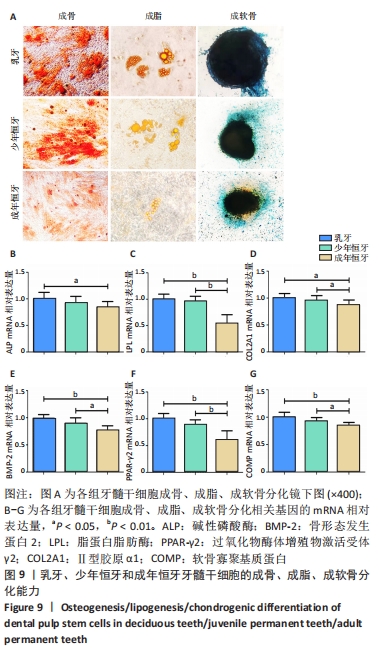[1] LARONI A, NOVI G, KERLERO DE ROSBO N, et al. Towards clinical application of mesenchymal stem cells for treatment of neurological diseases of the central nervous system. J Neuroimmune Pharmacol. 2013;8(5):1062-1076.
[2] ZHENG Q, ZHANG S, GUO WZ, et al. The Unique Immunomodulatory Properties of MSC-Derived Exosomes in Organ Transplantation. Front Immunol. 2021;12:659621.
[3] XU SJ, YE LP, WANG W, et al. Role of the Microenvironment in Mesenchymal Stem Cell-Based Strategies for Treating Human Liver Diseases. Stem Cells Int. 2021;2021:5513309.
[4] TUFAN AC. Mesenchymal Stem Cells as a Treatment Strategy for Coronavirus Disease 2019 (COVID-19): Need for Authority Regulations and Clinical Guidelines. Curr Stem Cell Res Ther. 2021;16(4):465-480.
[5] TANIKAWA DYS, PINHEIRO CCG, ALMEIDA MCA, et al. Deciduous Dental Pulp Stem Cells for Maxillary Alveolar Reconstruction in Cleft Lip and Palate Patients. Stem Cells Int. 2020;2020:6234167.
[6] YOUNG F, SLOAN A, SONG B. Dental pulp stem cells and their potential roles in central nervous system regeneration and repair. J Neurosci Res. 2013;91(11):1383-1393.
[7] CHEN D, KERR C. The Epigenetics of Stem Cell Aging Comes of Age. Trends Cell Biol. 2019;29(7):563-568.
[8] SPEHAR K, PAN A, BEERMAN I. Restoring aged stem cell functionality: Current progress and future directions. Stem Cells. 2020;38(9):1060-1077.
[9] REVUELTA M, MATHEU A. Autophagy in stem cell aging. Aging Cell. 2017; 16(5):912-915.
[10] MOHAMED HE, ASKER ME, KOTB NS, et al. Human platelet lysate efficiency, stability, and optimal heparin concentration required in culture of mammalian cells. Blood Res. 2020;55(1):35-43.
[11] 陈彦,杨雪婷,马悦,等.基于外泌体的牙髓再生策略[J].中华口腔医学杂志,2021,56(7):709-714.
[12] FERNANDES TL, CORTEZ DE SANTANNA JP, FRISENE I, et al. Systematic Review of Human Dental Pulp Stem Cells for Cartilage Regeneration. Tissue Eng Part B Rev. 2020;26(1):1-12.
[13] YOSHIMARU K, YAMAZA T, KAJIOKA S, et al. Dental pulp stem cells as a therapy for congenital entero-neuropathy. Sci Rep. 2022;12(1):6990.
[14] KOK ZY, ALAIDAROOS NYA, ALRAIES A, et al. Dental Pulp Stem Cell Heterogeneity: Finding Superior Quality “Needles” in a Dental Pulpal “Haystack” for Regenerative Medicine-Based Applications. Stem Cells Int. 2022;2022:9127074.
[15] GAZARIAN KG, RAMÍREZ-GARCÍA LR. Human Deciduous Teeth Stem Cells (SHED) Display Neural Crest Signature Characters. PLoS One. 2017;12(1): e0170321.
[16] TAKAOKA S, UCHIDA F, ISHIKAWA H, et al. Transplanted neural lineage cells derived from dental pulp stem cells promote peripheral nerve regeneration. Hum Cell. 2022;35(2):462-471.
[17] 刁树,杨东梅,范志朋.牙组织源性干细胞的微环境[J].中华口腔医学杂志,2014,49(4):254-256.
[18] WANG LH, GAO SZ, BAI XL, et al. An Up-To-Date Overview of Dental Tissue Regeneration Using Dental Origin Mesenchymal Stem Cells: Challenges and Road Ahead. Front Bioeng Biotechnol. 2022;10:855396.
[19] LI B, OUCHI T, CAO Y, et al. Dental-Derived Mesenchymal Stem Cells: State of the Art. Front Cell Dev Biol. 2021;9:654559.
[20] CHAN YH, LEE YC, HUNG CY, et al. Three-dimensional Spheroid Culture Enhances Multipotent Differentiation and Stemness Capacities of Human Dental Pulp-derived Mesenchymal Stem Cells by Modulating MAPK and NF-kB Signaling Pathways. Stem Cell Rev Rep. 2021;17(5):1810-1826.
[21] LOTT K, COLLIER P, RINGOR M, et al. Administration of Epidermal Growth Factor (EGF) and Basic Fibroblast Growth Factor (bFGF) to Induce Neural Differentiation of Dental Pulp Stem Cells (DPSC) Isolates. Biomedicines. 2023;11(2):255.
[22] RAJEWSKA J, KOWALSKI J, MATYS J, et al. The Use of Lactide Polymers in Bone Tissue Regeneration in Dentistry-A Systematic Review. J Funct Biomater. 2023;14(2):83.
[23] ISMAIL E, MABROUK M, SALEM ZA, et al. Evaluation of innovative polyvinyl alcohol/ alginate/ green palladium nanoparticles composite scaffolds: Effect on differentiated human dental pulp stem cells into osteoblasts. J Mech Behav Biomed Mater. 2023;140:105700.
[24] NAKAO Y, FUKUDA T, ZHANG Q, et al. Exosomes from TNF-α-treated human gingiva-derived MSCs enhance M2 macrophage polarization and inhibit periodontal bone loss. Acta Biomater. 2021;122:306-324.
[25] IRFAN M, CHUNG S. C5L2 modulates BDNF production in human dental pulp stem cells via p38α pathway. Sci Rep. 2023;13(1):74.
[26] KEARNEY M, DUNCAN HF. Micro-RNA Profiling in Dental Pulp Cell Cultures. Methods Mol Biol. 2023;2588:353-367.
[27] GOPINATH VK, MOHAMMAD MG, SHEELA S. Immunomodulatory effect of IL-1RA in LPS-activated macrophage/dental pulp stem cells co-culture. Int Endod J. 2023;56(1):27-38.
[28] ÖZGÜL ÖZDEMIR RB, ÖZDEMIR AT, KIRMAZ C, et al. Age-related changes in the immunomodulatory effects of human dental pulp derived mesenchymal stem cells on the CD4+ T cell subsets. Cytokine. 2021;138:155367.
[29] MAEDA H. Aging and Senescence of Dental Pulp and Hard Tissues of the Tooth. Front Cell Dev Biol. 2020;8:605996.
[30] WANG Z, LIN Y, JIN S, et al. Bone marrow mesenchymal stem cells improve thymus and spleen function of aging rats through affecting P21/PCNA and suppressing oxidative stress. Aging (Albany NY). 2020;12(12):11386-11397.
[31] AL-DALAHMAH O, NICHOLSON J, DRAIJER S, et al. Galectin-3 diminishes Wnt signaling in the postnatal subventricular zone. Stem Cells. 2020;38(9): 1149-1158.
[32] CHANG YM, SHIBU MA, CHEN CS, et al. Adipose derived mesenchymal stem cells along with Alpinia oxyphylla extract alleviate mitochondria-mediated cardiac apoptosis in aging models and cardiac function in aging rats. J Ethnopharmacol. 2021;264:113297.
[33] LI Y, ZHONG H, WU M, et al. Decline of p300 contributes to cell senescence and growth inhibition of hUC-MSCs through p53/p21 signaling pathway. Biochem Biophys Res Commun. 2019;515(1):24-30.
[34] HETTLER F, SCHRECK C, MARQUEZ SR, et al. Osteoprogenitor SFRP1 prevents exhaustion of hematopoietic stem cells via PP2A-PR72/130-mediated regulation of p300. Haematologica. 2023;108(2):490-501.
[35] MUTHUKRISHNAN SD, KAWAGUCHI R, NAIR P, et al. P300 promotes tumor recurrence by regulating radiation-induced conversion of glioma stem cells to vascular-like cells. Nat Commun. 2022;13(1):6202.
|









